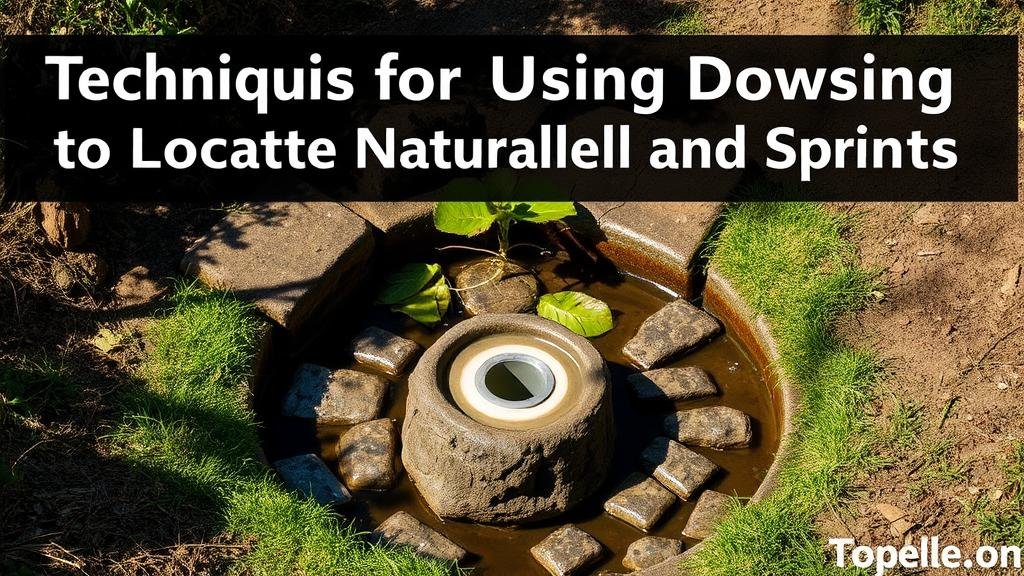Techniques for Using Dowsing to Locate Natural Wells and Springs
Techniques for Using Dowsing to Locate Natural Wells and Springs
Dowsing, also known as divining or water witching, is an ancient practice that involves using a tool, often a forked stick or L-shaped rod, to locate underground water sources, such as wells and springs. While dowsing has been met with skepticism by the scientific community, many practitioners claim to have successfully identified water locations through dowsing techniques. This article explores various dowsing methods, their history, effectiveness, and real-world applications, providing a comprehensive guide for those interested in natural resource exploration.
The Historical Context of Dowsing
Dowsing dates back several centuries, with evidence found in various cultures globally. In Europe, it was commonly practiced during the Middle Ages for locating minerals and water sources. The practice is recorded in texts as early as the 16th century, where it was used in Germany for mining purposes. In other cultures, such as Native American tribes, dowsing was recognized as a spiritual practice as well.
Despite its historical roots, modern science has yet to provide credible evidence supporting the effectiveness of dowsing. Nonetheless, many dowsers stand by their methods, often citing personal successes.
Understanding Dowsing Tools
Dowsing practitioners typically use a variety of tools to aid in their search for water. The most common include:
- Y-shaped stick: A traditional tool made from materials such as willow or hazel, held in both hands while walking over potential water sources.
- Robert Morgan rods: These L-shaped metal rods are held loosely, allowing them to move freely as the dowser walks over an area.
- Akashic pendulum: A weighted pendulum is swung to give responses based on the dowser’s questions or intentions.
Basic Dowsing Techniques
While individual approaches may vary, several fundamental techniques are widely used in dowsing for water. These include:
- Choosing a Site: Start by selecting a location where water may be present. Look for natural signs such as vegetation patterns, animal activity, or geological features indicative of underground water.
- Grounding Yourself: Touch the ground with your feet and take a moment to focus on your intentions. This step can help enhance sensitivity to underground signals.
- Walking the Area: Move slowly over the selected area while using your dowsing tool. Observe any movements or reactions from your tools.
- Recording Responses: Keep a journal of your findings, including where you felt the strongest responses and any accompanying geological observations.
Case Studies Highlighting Dowsing Effectiveness
Numerous anecdotal reports have documented successes in finding water using dowsing techniques. One notable case occurred in rural Texas, where a farmer successfully located an underground aquifer using a Y-shaped stick. Despite skepticism from local experts, the well that was drilled subsequently yielded a consistent water supply that helped sustain the farm.
Another example comes from a group of dowsers in France, who assisted local communities in locating natural springs to sustain agriculture. Their methods involved aerial photography combined with traditional dowsing techniques, resulting in the discovery of multiple viable water sources that enhanced local crop yields.
Critiques and Challenges of Dowsing
Dowsing faces criticism mainly due to the absence of scientific validation. Critics argue that success stories can often be attributed to coincidences or the skills of the dowser rather than the effectiveness of the method itself. Plus, subjective experiences often cloud the clarity of results.
To address these challenges, some modern dowsers encourage systematic testing of their methods and collaboration with geologists to better understand the geological factors affecting groundwater locations. This approach aims to bridge the gap between traditional dowsing practices and modern scientific methodologies.
Conclusion: The Future of Dowsing in Natural Resource Exploration
Despite the ongoing debate surrounding the efficacy of dowsing, it remains a popular practice for locating water sources, especially in areas lacking advanced technological resources. For aspiring dowsers, assessing their technique, refining their skills, and approaching the practice with an open yet critical mindset are vital for success.
Those interested in water resource exploration should consider investigating local geological features, employing different dowsing tools, and documenting their findings to develop their methods further. Ultimately, whether through dowsing or other means, securing access to clean, natural water sources remains essential for sustainable living.



